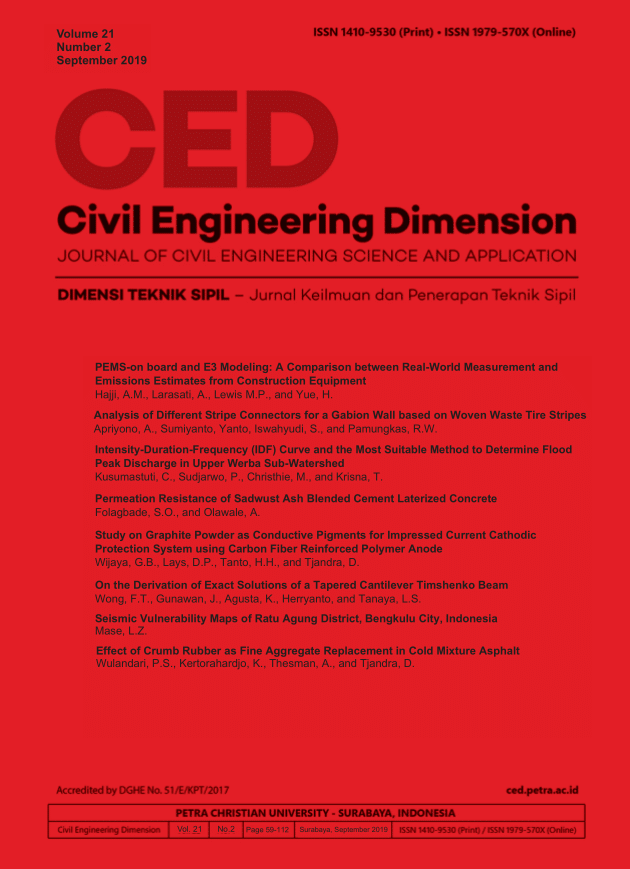Analysis of Different Stripe Connectors for a Gabion Wall based on Woven Waste Tire Stripes
 :
:
https://doi.org/10.9744/ced.21.2.66-69
Keywords:
Woven Waste Tire Stripe, Gabion Wall, Connector TypeAbstract
In this research, woven waste tire stripes are proposed as an alternative material to wire mesh to make a gabion wall. The performance of the waste tire stripe-based gabion wall is highly dependent on the strength of its stripe, where the stripe connector plays an important role. This research aims to inspect the behavior of different stripe connectors for the gabion wall. To achieve this, a physical model was built and employed to test the strength of the gabion wall. Various stripe connectors are used; adhesive rubber glue, one inch nail, and two mm wire. The strength capacity of the models was determined from the maximum stress before failure. The strength capacities of the models are 83.197, 59.426 and 62.397 kPa for the wire, nail, and glue connector, respectively. Hence, it can be inferred that the wire connector is the strongest of the three connectors.
References
BNPB, Bencana Menurut Jenisnya Di Indonesia Tahun 2009 S/D 2019, Jakarta, 2019.
Toprak, B., Sevim, O., and Kalkan, I., Gabion Walls and Their Use, International Journal Advance Mechanical Civil Engineering, 3(4), 2016, pp. 2394–2827,
Dekoruma, Kupas Tuntas Bronjong, dari Penahan Longsor Hingga Bagian Arsitektur Rumah, 2019. [Online]. Available: https://www.dekoruma. com/artikel/62125/apa-itu-bronjong. [Accessed: 25-Apr-2019].
Singh, J. and Singh, J., Application of Waste Tyre Rubber in Construction Industry, International Journal Civil, Structure Environment Infrastructure Engineering Research Dev., 5(3), pp. 57–64, 2015.
Bjegović, D., Baričević, A., and Serdar, M., Durability properties of concrete with recycled waste tyres, in International Conference on Durability of Building Materials and Composites, 2011, pp. 1659–1667.
Abas, F.O., Ghafoor, E.A.A., Abass, M.U., and Kamil, T., Re-Use of Waste Tires Rubber As Fine Aggregate Replacement, International Journal Engineering Science Research Technology, 4(3), 2015, pp. 110–120.
Nastain and Maryoto, A., Pemanfaatan Pemotongan Ban Bekas untuk Campuran Beton Serat Perkerasan Kaku, Dinamika Rekayasa, 6(1), 2010, pp. 14–18.
Apriyono, A., Sumiyanto, and Gusmawan, D.D., Application of Woven Tires Waste as soft Clay Subgrade Reinforcement for Preventing Highway Structural Failure, in AIP Conference Proceedings, 2017, 1818.
Cecich, V., Gonzales, L., Hoisaeter, A., and Williams, J., Use of Shredded Tires As Lightweight Backfill Material for Retaining Structures, Waste Management Reseach, 14, 1996, pp. 433–451.
Nakajima, Y., and Matsuyuki, M., Utilization of Waste Tires as Fuel for Cement Production, Resources, Conservation and Recycling, 4(3), 1981, pp. 145–151.
Apriyono, A., Sumiyanto, Yanto, and Bogie, A.H., Application of woven waste tires gabion wall as slope reinforcement for preventing landslide in Laboratory, MATEC Web of Conferences 195, 03007, 2018, pp. 1–8.
Downloads
Published
How to Cite
Issue
Section
License
Authors who publish with this journal agree to the following terms:- Authors retain the copyright and publishing right, and grant the journal right of first publication with the work simultaneously licensed under a Creative Commons Attribution License that allows others to share the work with an acknowledgement of the work's authorship and initial publication in this journal.
- Authors are able to enter into separate, additional contractual arrangements for the non-exclusive distribution of the journal's published version of the work (e.g., post it to an institutional repository or publish it in a book), with an acknowledgement of its initial publication in this journal.
- Authors are permitted and encouraged to post their work online (e.g., in institutional repositories or on their website) followingthe publication of the article, as it can lead to productive exchanges, as well as earlier and greater citation of published work (See The Effect of Open Access).

















